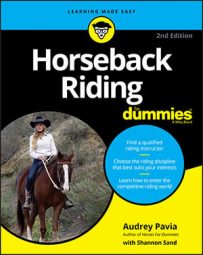The horse should be tied by the halter when you’re putting on the saddle. The saddle and pad go on before the bridle, and you remove the halter after you put on the bridle.
Before you saddle up the horse, do the following:- Tie the horse securely by his halter to a hitching post using a quick-release knot or cross-ties.
- Groom the horse thoroughly, being careful to brush down the hairs on the back and the girth area. Make sure no dirt, bedding, or other objects are stuck to these areas.
- Check the saddle blanket and girth or cinch to make sure that no burrs, sticks, or other items are clinging to the underside.
Western saddles
Before you start, familiarize yourself with the parts of the Western saddle. Be sure to have your saddle pad ready, too. Follow these steps to saddle your horse:1. Lay the pad on the horse’s back.
Stand on the horse’s left side and position the front of the pad a few inches in front of the horse’s withers, at the base of the neck.
2. Slide the pad backward a couple of inches so the front edge of the pad is still covering the withers.If you need to move the pad forward, don’t slide it, because doing so ruffles the hairs underneath, which can irritate the horse while you ride. Instead, lift the pad to move it forward. Check both sides of the horse to make sure that the amount of pad is even on the left and the right.
3. Prepare the saddle.On a Western saddle, the cinch is attached to the right side. Before you approach the horse with the saddle, flip the cinch up and place the ring at the end over the saddle horn. Take the right stirrup and loop it over the saddle horn on top of the cinch ring. This step keeps the cinch and the stirrup out of your way when you put the saddle on the horse.
4. Bring the saddle to the horse.Grasp the front of the saddle in your left hand and the back of the saddle in your right. Approach the horse’s left side.
Lift the saddle up to the height of the horse’s back a couple of times to get a sense of the weight of the saddle before you hoist it onto the horse’s back.
5. Place the saddle on the horse’s back.From the left side of the horse, swing the saddle up and over, and place it gently on the horse’s back. The saddle should sit in the hollow just below the withers with about 3 inches of the pad showing in front and in the back. To determine whether the saddle is correctly positioned on the horse’s back, look to see whether the cinch, when attached to the saddle, will fit just behind the horse’s elbows (see the following figure for the correct position of a Western saddle).
6. Walk around to the right side of the horse, unloop the stirrup from the saddle horn, and let it hang; undrape the cinch so it hangs down as well.7. Go back to the left side of the horse and secure the saddle with the cinch.
From the left side of the horse, reach underneath and take up the cinch. Run the latigo strap through the ring of the cinch, starting from the side closest to the horse, and then feed the strap through the same D-ring on the saddle where it’s attached, making sure the strap is flat and free of twists. Continue to loop the latigo strap through the two rings until you have about 12 inches of free strap coming from the ring attached to the saddle.
8. Make sure the cinch is snug enough that the saddle won’t move but not so snug that you can’t fit the fingers of a flat hand between the cinch and the horse’s body.To tighten the cinch, loosen the knot and pull up on the outside layer of strap between the D- and cinch rings.
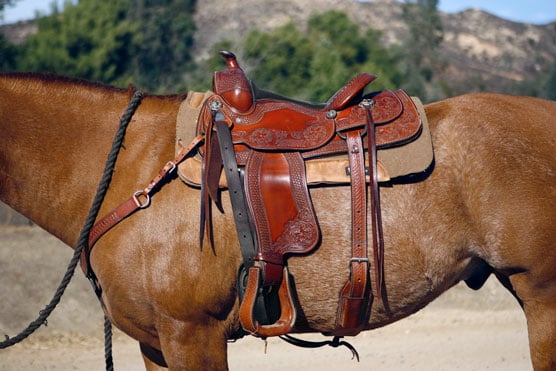 Photo courtesy of Sharon P. Fibelkorn
Photo courtesy of Sharon P. FibelkornCorrect placement of a Western saddle.
Check the cinch again after walking your horse a little and before mounting. You may need to retighten the cinch.
English saddles
You need to be familiar with the parts of an English saddle before you start saddling up. Then follow these steps to safely saddle a horse with an English saddle (have your pad and girth ready to go):1. Lay the pad on the horse’s back.
Stand on the horse’s left side and position the front of the pad a few inches in front of the horse’s withers, at the base of the neck.
2. Slide the pad backward a couple of inches so the front edge of the pad is still covering the withers.Don’t slide the pad forward if you need to reposition it because doing so ruffles the hairs underneath, which can irritate the horse — lift the pad instead. Check both sides of the horse to make sure that the amount of pad is even on the left and the right.
3. Pick up the saddle.Grasp the front of the saddle in your left hand and the back of the saddle in your right. Make sure you’ve pushed the stirrup irons up to the top of the stirrup leathers so they don’t flop around while you lift the saddle.
4. Place the saddle gently on the horse’s back in the hollow just below the withers.After placement, about 3 inches of the pad should be showing in front and back of the saddle. To ensure you’ve done it right, look to see whether the girth, when attached to the saddle, will fit just behind the horse’s elbows (see the following figure for the correct position of an English saddle).
5. Slide the girth straps on the left side of the saddle through the tab, the loop on the side of your saddle pad, from the top down.Go to the other side of the horse and repeat the process.
6. Fasten the girth to the right side of the saddle.Three girth straps, also known as billets, hang on the right side of the saddle, but you need to use only the outer two. The third one is present just in case one of the other straps breaks.
Bring the girth to the right side of the horse and fasten the girth’s buckles to the two outside girth straps hanging from the saddle. (Girths vary, so get help from your instructor regarding which side of the girth to fasten to which side of the saddle.) Fasten the buckles about halfway up each girth strap.
7. Fasten the girth to the left side of the saddle.Move to the horse’s left side and reach underneath the horse to grasp the girth. Follow the same buckling procedure that you did in Step 6. Before you attach the girth, be sure it rests just behind the horse’s elbows and that it isn’t twisted or covered with debris. Make the girth snug.
8. Gradually tighten the girth on the left side over a period of several minutes, one hole at a time.Doing so gradually is kinder to the horse. Make it snug enough that the saddle doesn’t move dramatically if you grab the pommel and move it from side to side. If you run out of holes on your left-side girth straps, begin tightening the buckles on the right. Ideally, you should have the girth attached at the same notch on both sides or as close as possible for even pressure.
9. Check your stirrup length.Before you mount, determine whether your stirrups are the correct length. One way to check whether you’re close is to slide your right hand, palm down, under the flap of the saddle where the stirrup leather attaches to the stirrup bar (the metal bar holding the stirrup leathers to the saddle); if your horse has already been bridled, hold the reins in your left hand while doing this. Using your left hand, grasp the stirrup iron and pull it toward the crook of your outstretched right arm, allowing the stirrup leather to lay flush against the bottom of your arm. If the stirrup iron fits snugly in the crook of your arm, the stirrups are most likely the correct length for your leg.
If your stirrups need lengthening or shortening, adjust them by using the buckle on the stirrup leather. After you’re finished, slide the stirrup leather buckle so it’s under the skirt and won’t rub on your leg when you’re riding.
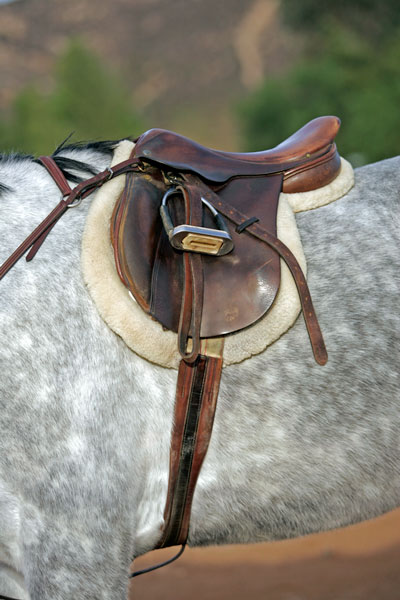 Photo courtesy of Sharon P. Fibelkorn
Photo courtesy of Sharon P. FibelkornThe girth fits well when you position an English saddle correctly.
Before you can mount, you may need to repeat Step 8 after leading your horse around. The girth may loosen after the horse starts moving. Before you get on, make sure that the girth is snug enough that it feels tight if you put your fingers between it and the horse’s body. If you can’t get your fingers in there, the girth is too tight and needs to be let out a notch.
Save the Bridling for Last
The bridle is the tack that goes on last. After you bridle your horse, you can’t tie him up again until you finish your ride. Before bridling your horse, do the following:- Tie the horse securely by his halter to a hitching post (using a quick release knot) or cross-ties.
- Groom and saddle the horse.
- Check the bridle to make sure that the noseband (the part that goes around the nose) and throatlatch (the strap that fastens around the horse’s jowls) on an English bridle are unbuckled. If you have a throatlatch on a Western bridle, make sure that it’s unbuckled, too.
- Have an experienced horse person (such as your riding instructor or trainer) help you determine whether the bit size is correct and how short the straps on the headstall should be if your horse has never worn this particular bridle.
1. Secure the horse with the halter.
Standing at the horse’s left side, unbuckle the halter, slide the noseband off, and then rebuckle the halter around the horse’s neck (see the earlier section on haltering for details).
2. Put the reins over the horse’s head so they lie on the horse’s neck.3. Hold the bit and headstall and stand at the left side of your horse’s head, facing the same direction that your horse is facing.
Grasp the top of the headstall in your right hand and the bit in your left hand. Let the bit lie against your outstretched fingers. Stand next to the horse’s head, still facing the same direction as the horse.
4. Place your right hand (still holding the headstall) just on top of the horse’s head, in front of his ears.If you can’t reach above the horse’s head, you can instead reach your arm under the horse’s jaw and around to the right side of the horse’s head so your right hand and the headstall are just above the horse’s forehead or above the bridge of his nose.
5. Open the horse’s mouth and insert the bit.With your left thumb, gently press down on the inside corner of the horse’s lip to open his mouth and gently guide the bit into the horse’s mouth, being careful not to bang it against his front teeth. Raise the headstall in your right hand until the bit slides all the way in to the horse’s mouth. If the bridle has a curb chain, make sure it rests behind the horse’s chin.
6. Gently slide the headstall over the horse’s ears.Adjust the browband so it sits evenly on the horse’s forehead, or make sure the horse’s ear or ears fit comfortably through the one- or two-ear loops. The bridle is now in place.
7. Buckle the throatlatch and noseband, if any.-
- Western bridle: This figure shows a horse with a Western bridle. You probably won’t have a noseband to tighten. If the bridle has a throatlatch, make sure that two fingers fit between the horse and the strap.
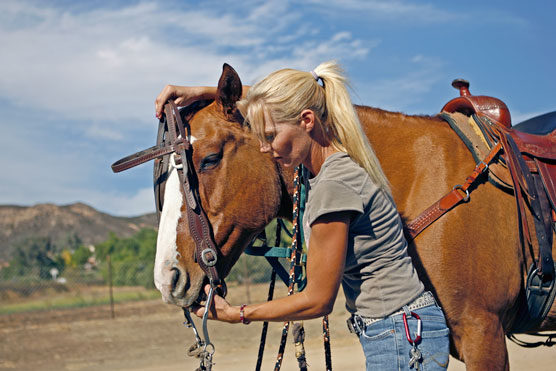 Photo courtesy of Sharon P. Fibelkorn
Photo courtesy of Sharon P. FibelkornPutting on a Western bridle.
-
- English bridle: This figure shows a horse with an English bridle. The throatlatch and noseband should be snug but not so tight that you can’t get three fingers between them and the horse.
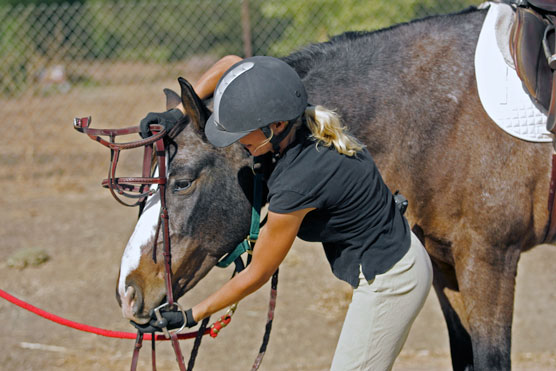 Photo courtesy of Sharon P. Fibelkorn
Photo courtesy of Sharon P. FibelkornPutting on an English bridle.
If a curb chain or strap is attached to the bit, make sure that it’s loose when you let the reins go slack but that it makes contact with the horse’s chin when you pull the bit shanks back at a 45-degree angle.
8. Unbuckle the halter from your horse’s neck.If you plan to mount where you are, leave the reins over your horse’s neck. If you want to lead your horse to another area for mounting, remove the reins from over your horse’s neck and lead the horse by the reins.

